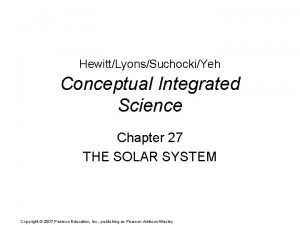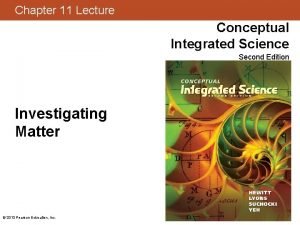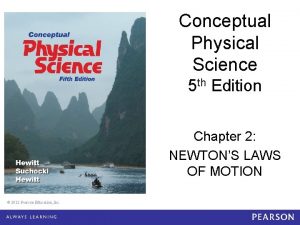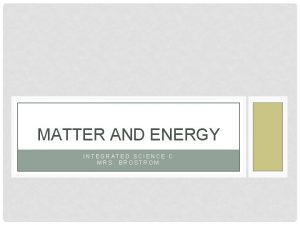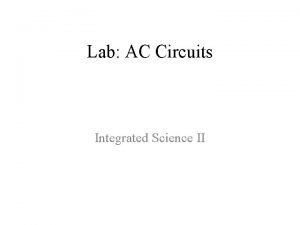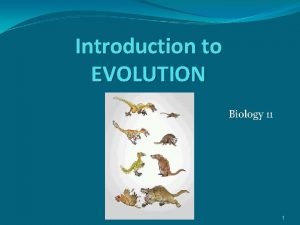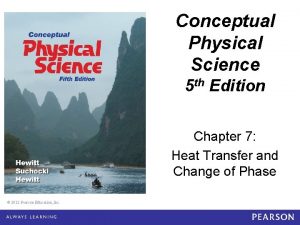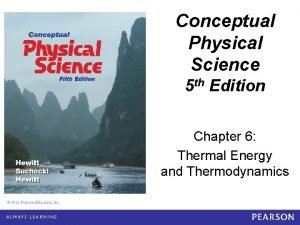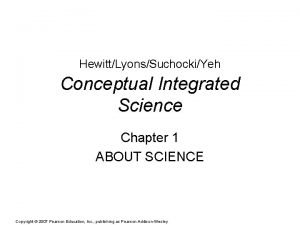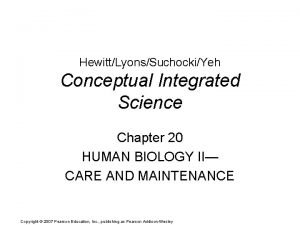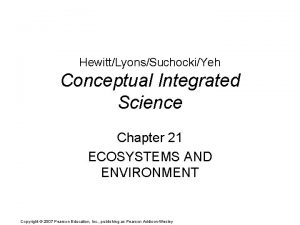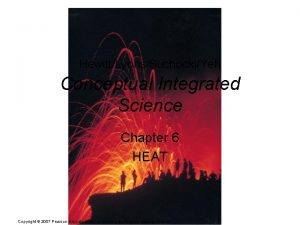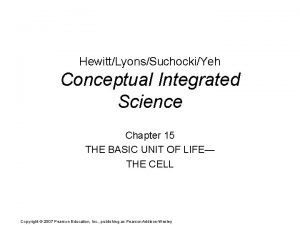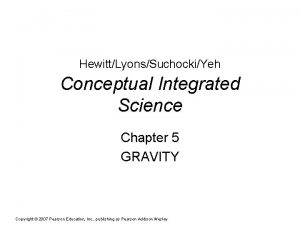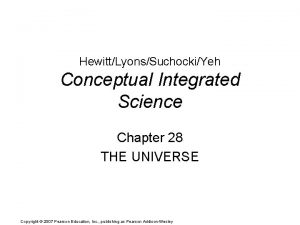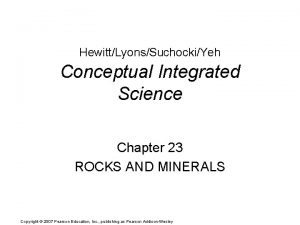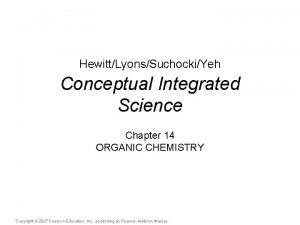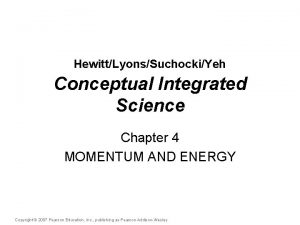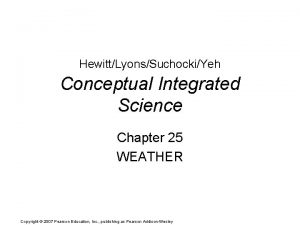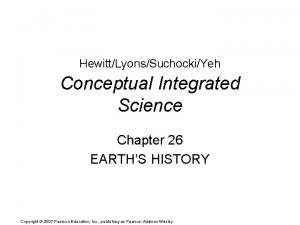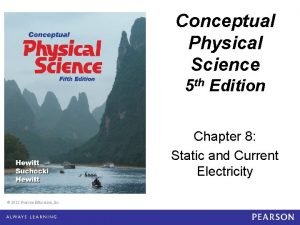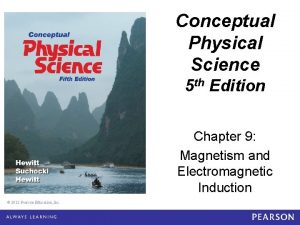HewittLyonsSuchockiYeh Conceptual Integrated Science Chapter 17 THE EVOLUTION





































- Slides: 37

Hewitt/Lyons/Suchocki/Yeh Conceptual Integrated Science Chapter 17 THE EVOLUTION OF LIFE Copyright © 2007 Pearson Education, Inc. , publishing as Pearson Addison-Wesley

This lecture will help you understand: • • • The Origin of Life Early Life on Earth The First Eukaryotic Cells Charles Darwin and The Origin of Species How Natural Selection Works Integrated Science: Animal Adaptations to Heat and Cold How Species Form Evidence of Evolution Does Evolution Occur Gradually or in Spurts? The Evolution of Humans Science and Society: Antibiotic-Resistant Bacteria Copyright © 2007 Pearson Education, Inc. , publishing as Pearson Addison-Wesley

The Origin of Life For thousands of years, people believed that life was created through spontaneous generation, the sudden emergence of living organisms from nonliving material. Copyright © 2007 Pearson Education, Inc. , publishing as Pearson Addison-Wesley

The Origin of Life Louis Pasteur proved that spontaneous generation was not the explanation for the origin of life. Copyright © 2007 Pearson Education, Inc. , publishing as Pearson Addison-Wesley

The Origin of Life The Miller and Urey experiment modeled the young Earth’s atmosphere and water. When Miller and Urey shot electric sparks through the mixture, complex organic molecules formed. Copyright © 2007 Pearson Education, Inc. , publishing as Pearson Addison-Wesley

The Origin of Life Alternate hypotheses for the origin of organic molecules on Earth: • Organic molecules came to Earth on incoming meteorites. • Organic molecules were synthesized in deep sea vents. Copyright © 2007 Pearson Education, Inc. , publishing as Pearson Addison-Wesley

The Origin of Life Scientists now believe that the first genes were probably made of RNA. Short strands of RNA can spontaneously assemble from individual nucleotides. RNA can even replicate by itself. Copyright © 2007 Pearson Education, Inc. , publishing as Pearson Addison-Wesley

Early Life on Earth The earliest living organisms were: • Marine prokaryotes • Living with no free oxygen • Heterotrophs (obtaining energy and food from outside sources) • Producing energy via anaerobic processes Copyright © 2007 Pearson Education, Inc. , publishing as Pearson Addison-Wesley

Early Life on Earth Autotrophs—organisms that convert inorganic materials into food and organic molecules—evolved later. But this was a key event in the history of life! Copyright © 2007 Pearson Education, Inc. , publishing as Pearson Addison-Wesley

Early Life on Earth Cyanobacteria—photosynthetic bacteria— produced oxygen as a by-product of photosynthesis, introducing oxygen into the Earth’s atmosphere. Copyright © 2007 Pearson Education, Inc. , publishing as Pearson Addison-Wesley

The First Eukaryotic Cells Eukaryotes: • First appeared about 2 billion years ago. • The nucleus and most organelles probably originated from inward foldings of the cell membrane. • According to the endosymbiotic theory, mitochondria and chloroplasts evolved from prokaryotes living inside the earliest eukaryotic cells. Copyright © 2007 Pearson Education, Inc. , publishing as Pearson Addison-Wesley

The First Eukaryotic Cells Mitochondria likely evolved from a group of oxygen-breathing bacteria. Chloroplasts probably evolved from cyanobacteria. Copyright © 2007 Pearson Education, Inc. , publishing as Pearson Addison-Wesley

Charles Darwin and The Origin of Species Jean Baptiste Lamarck argued that fossils were relics of the ancestors of modern species. Lamarck believed that organisms acquired new traits over their lifetimes and then passed them on to their offspring. He called this the inheritance of acquired characteristics. Copyright © 2007 Pearson Education, Inc. , publishing as Pearson Addison-Wesley

Charles Darwin and The Origin of Species Darwin argued that evolution—heritable changes in organisms over time— explained the origin of all organisms on Earth. Copyright © 2007 Pearson Education, Inc. , publishing as Pearson Addison-Wesley

Charles Darwin and The Origin of Species Darwin was inspired by: • His travels on the Beagle. • The work of geologist Charles Lyell, who proposed that the Earth’s features developed gradually over millennia. • The work of economist Thomas Malthus, who wrote about famine and the struggle of humans over resources. Copyright © 2007 Pearson Education, Inc. , publishing as Pearson Addison-Wesley

Charles Darwin and The Origin of Species Darwin’s Galápagos Island finches were significant because they provided what appeared to be an example of how a single species could evolve into multiple species, each adapted to a different lifestyle. The 13 species of finches he found varied in beak size and shape, depending on their diet. Copyright © 2007 Pearson Education, Inc. , publishing as Pearson Addison-Wesley

How Natural Selection Works • In any population, individuals have traits, many of which show variation. • Traits that are determined by genes are heritable. • Advantageous traits benefit an organism and allow it to leave more offspring—this is natural selection. • Advantageous traits become more common in a population, resulting in adaptation. Copyright © 2007 Pearson Education, Inc. , publishing as Pearson Addison-Wesley

How Natural Selection Works Copyright © 2007 Pearson Education, Inc. , publishing as Pearson Addison-Wesley

How Natural Selection Works Adaptations are traits that make an organism better suited to living in and reproducing in its environment. • Many adaptations help organisms survive. • Some adaptations help organisms attract mates—this is called sexual selection. • Other adaptations relate to bearing and raising offspring. Copyright © 2007 Pearson Education, Inc. , publishing as Pearson Addison-Wesley

Integrated Science: Animal Adaptations to Heat and Cold Animals thermoregulate: • Surface-to-volume ratio is an important factor in heat balance. • Bergmann’s Rule says that animals found in cold habitats are often larger than related forms in warm habitats. • Allen’s Rule states that appendages will be longer/larger in hot-climate animals and shorter/smaller in cold-climate animals. Copyright © 2007 Pearson Education, Inc. , publishing as Pearson Addison-Wesley

Integrated Science: Animal Adaptations to Heat and Cold Animals also control body temperature with: • Coloration • Insulation Copyright © 2007 Pearson Education, Inc. , publishing as Pearson Addison-Wesley

How Natural Selection Works Natural selection is classified into three modes: • Directional selection • Stabilizing selection • Diversifying selection Copyright © 2007 Pearson Education, Inc. , publishing as Pearson Addison-Wesley

How Natural Selection Works The Modern Synthesis incorporates modern genetics into Darwin’s theory of evolution. It focuses on evolution as changes in the allele frequencies of genes over time. Copyright © 2007 Pearson Education, Inc. , publishing as Pearson Addison-Wesley

How Natural Selection Works Four different mechanisms produce evolution: • • Natural selection Mutation pressure Genetic drift Migration Copyright © 2007 Pearson Education, Inc. , publishing as Pearson Addison-Wesley

How Species Form A species is a group of organisms whose members can interbreed with each other but not with members of other species. The key to speciation—the development of new species—is the evolution of reproductive barriers that prevent two groups of organisms from interbreeding. Copyright © 2007 Pearson Education, Inc. , publishing as Pearson Addison-Wesley

How Species Form There are two kinds of reproductive barriers: • Prezygotic reproductive barriers prevent members of different species from mating in the first place or prevent fertilization from occurring. • Postzygotic reproductive barriers prevent hybrids from surviving or from reproducing if they do survive. Copyright © 2007 Pearson Education, Inc. , publishing as Pearson Addison-Wesley

How Species Form CHECK YOUR NEIGHBOR Is a mule an example of a prezygotic reproductive barrier or a postzygotic reproductive barrier? Explain your answer to your neighbor. Copyright © 2007 Pearson Education, Inc. , publishing as Pearson Addison-Wesley

How Species Form CHECK YOUR ANSWER A mule provides an example of a postzygotic reproductive barrier. It is the hybrid offspring of two different species, a horse and a donkey. Mules are sterile and cannot reproduce. Copyright © 2007 Pearson Education, Inc. , publishing as Pearson Addison-Wesley

How Species Form New species may develop as a result of: • Allopatric speciation (geographic barriers dividing a population in two) • Sympatric speciation (speciation without a geographic barrier). Examples: hybridization and chromosomal changes, such as polyploidy. Copyright © 2007 Pearson Education, Inc. , publishing as Pearson Addison-Wesley

Evidence of Evolution Evidence for evolution includes: • Natural selection in action • Human-imposed artificial selection (e. g. , domesticated animals and plants) • Shared anatomy, patterns of development, and DNA among living creatures • The fossil record • Biogeography Copyright © 2007 Pearson Education, Inc. , publishing as Pearson Addison-Wesley

Evidence of Evolution Copyright © 2007 Pearson Education, Inc. , publishing as Pearson Addison-Wesley

Evidence of Evolution Copyright © 2007 Pearson Education, Inc. , publishing as Pearson Addison-Wesley

Does Evolution Occur Gradually or in Spurts? Gould and Eldredge proposed theory of punctuated equilibrium—species maintain stability (“equilibrium”) for long periods and then evolve in rapid bouts (“punctuated”) that occur during speciation. Copyright © 2007 Pearson Education, Inc. , publishing as Pearson Addison-Wesley

The Evolution of Humans are: • Primates—we share an ancestry with monkeys and apes • Hominids—the primate group that includes Homo sapiens and extinct relatives Copyright © 2007 Pearson Education, Inc. , publishing as Pearson Addison-Wesley

The Evolution of Humans The fossil record has allowed us to document some aspects of human evolution. Copyright © 2007 Pearson Education, Inc. , publishing as Pearson Addison-Wesley

Science and Society: Antibiotic-Resistant Bacteria Antibiotic resistance is the result of natural selection. When a patient takes a course of antibiotics, a few naturally resistant bacteria may survive the treatment. These reproduce. Eventually, strains of bacteria exist that cannot be controlled by the antibiotic. All antibiotic use contributes to antibiotic resistance. Copyright © 2007 Pearson Education, Inc. , publishing as Pearson Addison-Wesley

Science and Society: Antibiotic-Resistant Bacteria Ways to slow the development of antibiotic resistance in bacteria: • Take antibiotics only when needed • Take the entire course of antibiotics • Use antibiotics responsibly in agriculture Copyright © 2007 Pearson Education, Inc. , publishing as Pearson Addison-Wesley
 Conceptual integrated science explorations
Conceptual integrated science explorations Conceptual integrated science
Conceptual integrated science Maths is my favourite subject
Maths is my favourite subject Conceptual physical science practice sheet chapter 2
Conceptual physical science practice sheet chapter 2 What is matter in integrated science
What is matter in integrated science Lone star nursing
Lone star nursing Investigating conductors lab report
Investigating conductors lab report Chs hcpss
Chs hcpss Evolution examples
Evolution examples Conceptual physical science 5th edition
Conceptual physical science 5th edition Bimetallic strip
Bimetallic strip Conceptual physical science 5th edition
Conceptual physical science 5th edition What is conceptual framework of science education
What is conceptual framework of science education Hát kết hợp bộ gõ cơ thể
Hát kết hợp bộ gõ cơ thể Frameset trong html5
Frameset trong html5 Bổ thể
Bổ thể Tỉ lệ cơ thể trẻ em
Tỉ lệ cơ thể trẻ em Chó sói
Chó sói Tư thế worms-breton
Tư thế worms-breton Alleluia hat len nguoi oi
Alleluia hat len nguoi oi Các môn thể thao bắt đầu bằng tiếng nhảy
Các môn thể thao bắt đầu bằng tiếng nhảy Thế nào là hệ số cao nhất
Thế nào là hệ số cao nhất Các châu lục và đại dương trên thế giới
Các châu lục và đại dương trên thế giới Công thức tính độ biến thiên đông lượng
Công thức tính độ biến thiên đông lượng Trời xanh đây là của chúng ta thể thơ
Trời xanh đây là của chúng ta thể thơ Cách giải mật thư tọa độ
Cách giải mật thư tọa độ Phép trừ bù
Phép trừ bù độ dài liên kết
độ dài liên kết Các châu lục và đại dương trên thế giới
Các châu lục và đại dương trên thế giới Thơ thất ngôn tứ tuyệt đường luật
Thơ thất ngôn tứ tuyệt đường luật Quá trình desamine hóa có thể tạo ra
Quá trình desamine hóa có thể tạo ra Một số thể thơ truyền thống
Một số thể thơ truyền thống Cái miệng xinh xinh thế chỉ nói điều hay thôi
Cái miệng xinh xinh thế chỉ nói điều hay thôi Vẽ hình chiếu vuông góc của vật thể sau
Vẽ hình chiếu vuông góc của vật thể sau Thế nào là sự mỏi cơ
Thế nào là sự mỏi cơ đặc điểm cơ thể của người tối cổ
đặc điểm cơ thể của người tối cổ V cc
V cc Vẽ hình chiếu đứng bằng cạnh của vật thể
Vẽ hình chiếu đứng bằng cạnh của vật thể
